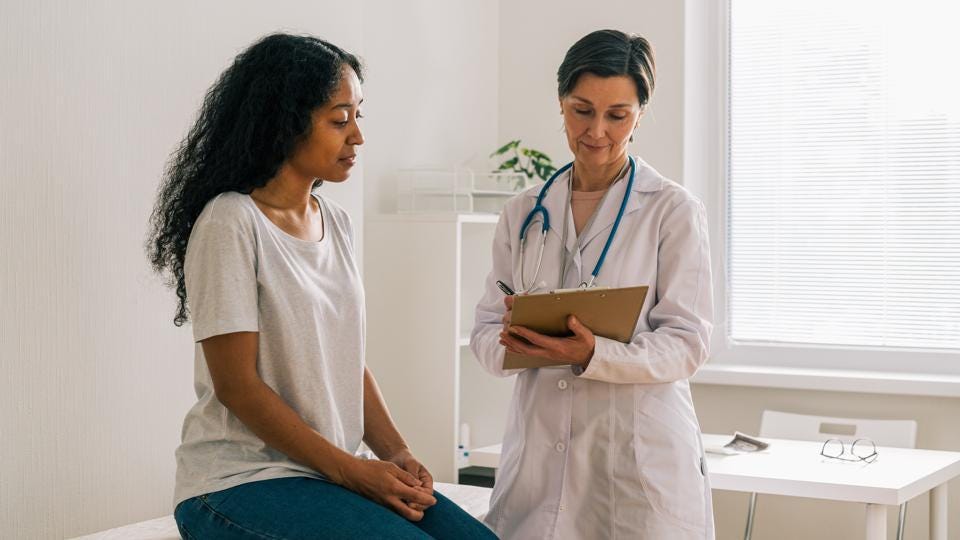During a well woman exam, your doctor will review all of your current medical issues and determine if there is anything missing from care, says Dr. Marchand. It is important to note that medicine is constantly changing, so treatment that is recommended can vary a lot in just one year, he adds. The doctor should examine you from head to toe, check your vital signs, and assess if you are due for any vaccines. The visit generally includes the following:
Health History and Physical Examination
Upon arrival, you will undergo a routine physical exam that includes taking your weight, pulse and blood pressure. A urine sample may be requested to test for sexually transmitted diseases (STDs) and rule out urinary tract infections, says Dr. Alagia. “You will be asked to change into a gown after being left alone in the examination room. Once your health care professional enters the room, they should take a few moments to review the exam they are planning to perform and explain the reason for the specific exam,” he says.
You’ll have time before, after and during the exam to ask and answer any questions you and your health care provider might have. It’s useful to prepare a list of questions in advance.
The questions that your doctor asks will be tailored to your age and medical history, says Dr. Swarup. For example, they may ask if you smoke, use drugs or alcohol, have any allergies or infections and whether you’ve had any surgeries, he says––all of these factors can affect your reproductive health.
Your doctor may ask the following questions, according to Dr. Swarup:
How long ago was your last period?
How often do your periods occur and how long do they last?
Is there spotting between your periods?
Is there any vaginal itching, pain or discharge?
Are you experiencing any medical concerns?
Do any members of your family have medical issues?
How often are you sexually active, and do you have a new partner?
What type of sex do you have? Is it painful? Do you ever bleed after?
Do you use birth control?
Are you concerned you might be pregnant?
Are you trying to get pregnant?
What do you use to prevent sexually transmitted diseases (STDs)?
It’s important to be completely honest in your answers because the questions are to benefit your health, says Dr. Marchand. “Remember that a doctor can never share any personal information about your visit (doing so could easily lead to medical board discipline or loss of licensure),” he says. Doctors can share your information with other members of their health team if it is necessary to provide your care or coordinate your care. Doctors can also share your information with your permission. Doctors can also share your information with law enforcement to prevent or lessen a serious and imminent threat to the health or safety of an individual or the public. Dr. Alagia adds that having an honest dialogue with your health care professional helps them recommend guideline-based care such as STD screening, cancer screenings and other services.
You should also expect questions about your diet, life stressors and exercise habits, says Dr. Marchand. “Since screening for depression and anxiety is very important for all patients, you should be ready for questions about how you’re feeling,” he says.
Breast Exam
Starting at the age of 20, a breast exam may be conducted every one to three years to identify any irregularities or lumps, says Dr. Swarup, but recommendations vary. For example, the ACOG advises that clinical breast examinations may be offered every one to three years in women ages 25 to 39, and once a year in women over the age of 40.
The American Cancer Society does not recommend clinical breast exams nor self breast exams at all due to lack of evidence that it contributes very little to early breast cancer detection when mammography is available. Currently, mammograms (x-ray images of the breast) are recommended annually in women over the age of 45 and once every two years in women over the age of 55.
The ACOG that women between the ages of 25 and 39 be offered a clinical breast exam every one to three years, and that women over the age of 40 be offered them annually. In either case, the ACOG recommends women make the decision that’s best for them.
If your practitioner conducts a clinical breast exam, you will be asked to lift one arm behind your head, explains Dr. Alagia. This allows your doctor to better examine each breast, applying gentle pressure in circular movements. “They will look for abnormal lumps or cysts. If any lumps are discovered, a biopsy will be ordered to determine if they are cancerous or not,” says Dr. Alagia.
Pelvic Exam
A pelvic, or internal exam, is performed to check the vulva, vagina, cervix, fallopian tubes, ovaries and rectum for abnormalities. Adolescents don’t need a pelvic exam unless they are experiencing abnormal bleeding, discharge, or pelvic pain. It’s unlikely that you’ll have a pelvic exam before the age of 21 unless such symptoms are present. Although the exam may be uncomfortable, it should not be painful. Keeping your body relaxed will help minimize discomfort.
During a pelvic exam, your doctor will also examine your vulva and rectum for irritation, redness or other signs of anything concerning, says Dr. Swarup. A lubricated speculum is placed into the vagina to look inside it, allowing the cervix to be evaluated for signs of disease. After removing the speculum, your doctor will gently insert one or two fingers (using a lubricated glove) into your vaginal canal while placing gentle pressure on the lower abdomen, explains Dr. Alagia. This allows them to check for abnormalities in the size, shape, and position of the uterus and ovaries.
You can expect to feel pressure, says Dr. Alagia, adding that it’s important to communicate any feelings of pain, heaviness, bloating or tenderness––this helps your doctor understand potential causes for concern.
Cervical Cancer Screening
Depending on your age, you may undergo cervical cancer screening via a Pap smear and/or human papillomavirus (HPV) test during your pelvic exam. A Pap smear looks for cellular changes in the cervix that may turn into cervical cancer, and an HPV test checks for the presence of the human papillomavirus, the virus responsible for causing these changes.
Current U.S. Preventive Services Task Force guidelines advise that women between the ages of 21 and 29 be screened every three years with a Pap smear alone; women ages 30 to 65 may be screened every three years with a Pap test only, every five years with HPV testing only or every five years with both.
For both HPV and Pap tests, your health care practitioner will insert a lubricated speculum into your vaginal canal to view your vagina and cervix, explains Dr. Alagia. “They will swipe your cervix with a swab and send it to a lab to ensure there are no signs of cervical cancer and ensure your cervix is healthy,” he says.
Sexually Transmitted Disease (STD) Screening
Even if you think you are not at risk, you should discuss STD screening with your doctor, says Dr. Alagia. Currently, the Centers for Disease Control and Prevention (CDC) recommends the following testing schedule for STDS:
All adults and adolescents ages 13 to 64 should be tested at least once for HIV.
All sexually active women younger than 25 should be tested for gonorrhea and chlamydia yearly, and women over 25 with new or multiple sex partners or a sex partner with an STD should be tested yearly.
Pregnant women should be tested for syphilis, HIV, hepatitis B and hepatitis C early in their pregnancy, and those who are at risk (new or multiple sex partners) should also be tested for chlamydia and gonorrhea.
At Home HPV Testing
Nurx’s quick, easy and at home HPV test screens for the strains of HPV that potentially lead to cervical cancer. It’s quick, easy and can be done by you in the privacy of your own home.
Get Started
Discovered on: 2022-11-10 21:13:57
Source: What To Expect During Your First Women’s Wellness Exam – Forbes Health


